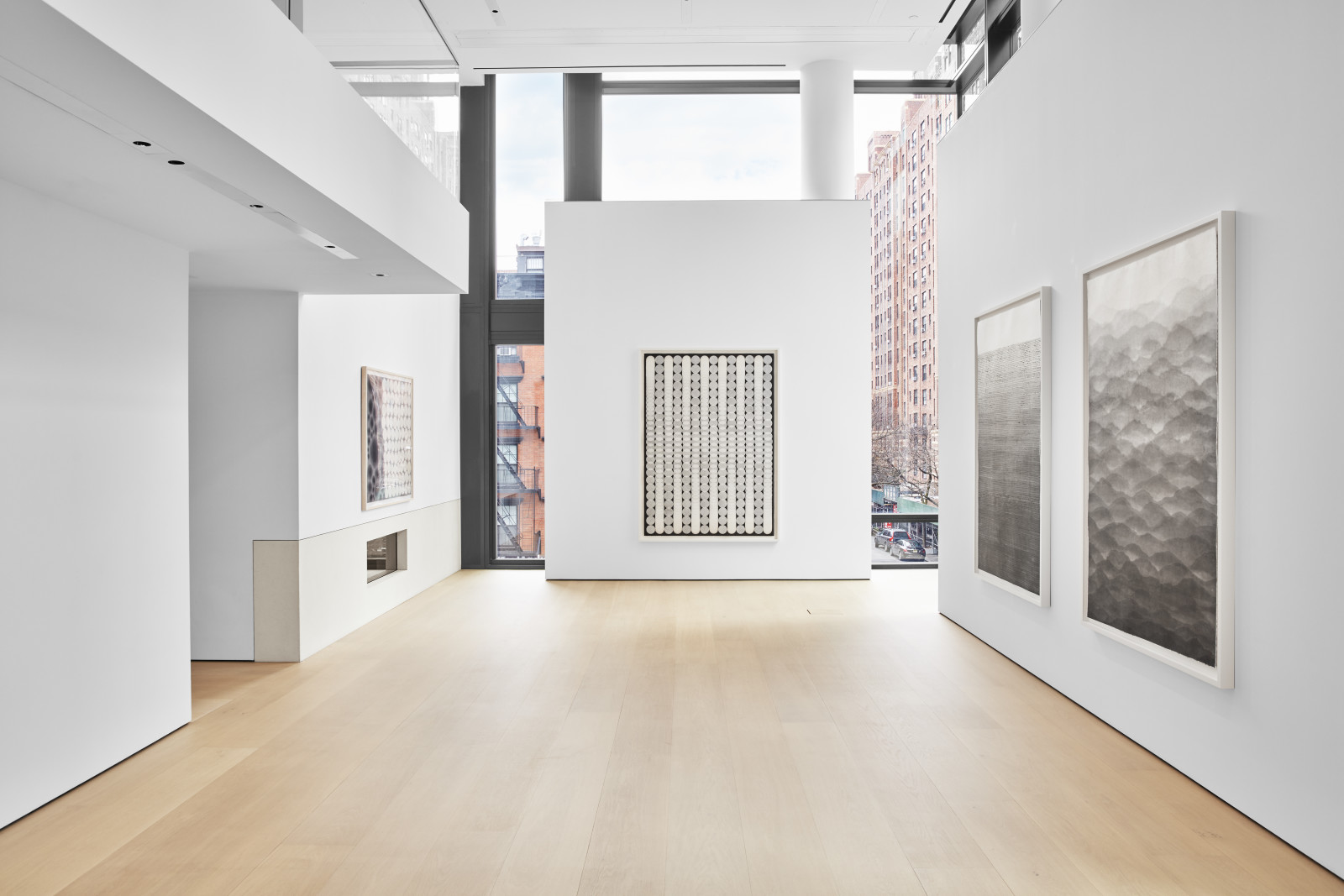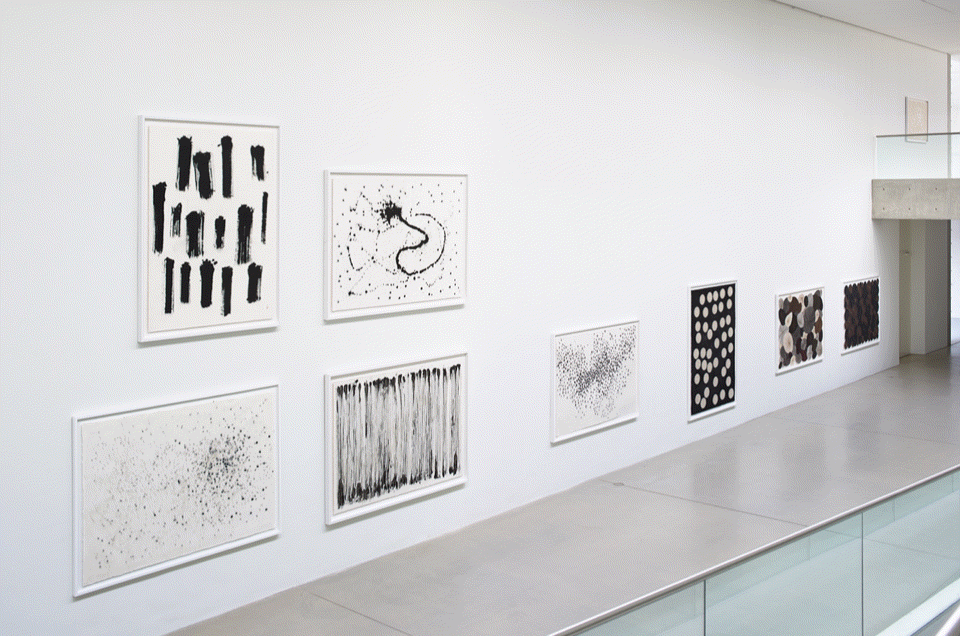The Street
2020
Mixed media on mulberry Hanji paper
141 × 202 cm / 55.51 × 79.53 in
|
|
|
|
Minjung Kim has been exploring the artistic movements of the East and West, using black ink to draw lines or create spontaneous strokes, and repeatedly pastes the layers of Hanji paper which she delicately burns with incense sticks and candles. The use of Hanji and fire as a medium and the subtle, repetitive handwork add depth to her work with a formal richness and unsuspected poetic variations.
The careful choice of materials, delicate and controlled burning, and a patient collage of thin Hanji paper every element in the work of Minjung Kim reflects concentration and contemplation. The repetitious and reflective process is an important part of her work,which leads to meditation and healing.
Minjung Kim’s The Street series is a result of repetitive collaging the burnt Hanji papers with slightly different colors one by one. This work, which resembles a street filled with colorful umbrellas on a rainy day, offers a chance to witness the subtle and unique characteristic of the material and the artist’s meditative breath and touch infused on the work.
|
|
|
|
“I attempt to express the law of nature → mutation → birth, death.
Burning paper means performing a rite that makes me a participant in this process. I insert the void by burning in the filled space. I place layers of brunt paper on top of ink traces : during this process I feel the sensation
I experienced in my childhood when I watched dry leaves burning in autumn.”
- Minjung Kim
|
|
|
|
Phasing
2019
Mixed media on mulberry Hanji paper
205 × 140 cm / 80.71 × 55.12 in |
|
|
|
First introduced in 2017, the Phasing series works are produced through the process of brushstroke making on Hanji paper, addition of another layer of Hanji and the burning of paper along the ink’s trajectory. In this work, the viewers can vividly feel the artist’s breath and touch while the original characteristics of Hanji are visually maximized. In particular, the Phasing series shows the artist's intention to symbolically represent repetitive chronic cycles and traces of time from the use of paper made of trees and the ink made by burnt trees. |
|
|
|
Phasing
2019
Mixed media on mulberry Hanji paper
140 × 75.5 cm / 55.12 × 29.72 in
|
|
|
|
“I am always aware of the importance of equilibrium.
You can call it Yin and Yang as in traditional Asian philosophy or just simply a balance between the opposites.”
- Minjung Kim
|
|
|
|
Minjung Kim (b. 1962) is a contemporary Korean artist best known for her ink paintings by their transparency as well as her subtle formal compositions on layered paper. Committed to re-interpreting traditional Korean aesthetics, Kim employs a process-based organization of her thoughts, problems, and whims in each of her artworks. Through the repetitive work of burning and layering mulberry Hanji paper, she conveys the process of emotional healing and meditation. Often colorful and staccato, the artist describes her calligraphic work in emotional terms: “The movement, the colors, they are so calm and peaceful. They are my state of mind,” she says.
Born in 1962 in Gwangju, Republic of Korea, Kim was encouraged by her family to pursue her artistic inclination from an early age, studying under various teachers including famed watercolorist Yeongyun Kang, and between the ages of thirteen and twenty-nine, Oriental calligraphy. This latter study allowed her to understand the fundamental precepts of Asiatic speculative tradition. The study of calligraphy did not just endow Minjung with this vision of the world but also taught her to communicate by means of the extremely controlled use of the brush, which “channels” the energy and directs it onto the paper.
When in 1980 she enrolled in the Hongik University in Seoul, Minjung had already received a very thorough artistic education which was completed through the detailed study of Oriental painting. Once her university course had been completed in 1985, she took a Master’s degree at the same university with a thesis on the four basic materials in ink painting (mulberry Hanji paper, brush, ink pigment and the pigment grinding stone).
Out of her curiosity about the Italian art which led Renaissance, she decided to move to Milan, Italy and later graduated from the Brera Academy of Fine Art in 1991. Here she studied less the basics of European painting, which she had already tackled at university in Korea, than the analysis of the works of Western artists who, during the 20th century, studied Oriental painting. In particular, certain works by Paul Klee and Franz Kline prompted her to approach a new aesthetic direction that took her progressively away from the figurative tradition of her country of origin towards an investigation of the expressive value of marks and maculas, two stylistic elements that combine perfectly with the “process-based view of the world” and the ability to “channel the energy”, both of which she learned in her study of calligraphy. “Unlike the concept in Korea, there is no distinction between Eastern and Western art. It is more of a matter of differences in materials.” The reason why Kim has chosen mulberry Hanji paper is that it is the best material which she could handle. She began with expressing the musical rhythm through ink, and later went beyond hand-drawing, committing herself to the natural lines created by candle light or incense burn.
Her work is represented in numerous international public collections including the British Museum, London, UK; Leeum, Samsung Museum of Art, Seoul, Korea; Musée des Arts Asiatiques, Nice, France; Fundación Helga de Alvear, Cáceres, Sapin; Swiss Re Art Collection, Zürich, Switzerland; Herbert F. Johnson Museum of Art, Cornell University, New York, USA; Asia Society Museum, New York, USA; Fondazione Palazzo Bricherasio, Turin, Italy; the Museum Sbygningen, Copenhagen, Denmark; OCI Museum of Art, Seoul, Korea; and UniCredit Art Collection, Milan, Italy. She currently lives and works between France and the United States.
|
|
|
|
 | Installation view of exhibition Minjung Kim ©Hill Art Foundation Photo by Matthew Herrmann | |
|
|
Minjung KimHill Art Foundation, New York through January 1, 2021
|
|
|
|
“The exhibition is a close collaboration between the artists and curatorial advisor Boon Hui Tan, the Director of the Asia Society Museum and the Asia Society’s Vice President for Global Artistic Programs. Structured to include 37 paintings drawn from all major stages of Kim’s career, the exhibition showcases the astonishing range of her exploration of the interaction between ink and paper. [...] Working with limited materials—Hanji, glue, fire, air, and, occasionally, color—Kim nonetheless creates a varied body of work. In certain series, she dyes the Hanji or builds a tonal scale by precisely manipulating the absorption of ink, as in the Mountain series—monochromatic works composed of horizontal, undulating waves of black, blue, or red ink applied to Hanji paper in varying densities and shades.”
|
|
|
|
 | Installation view of exhibition Minjung Kim at the Langen Foundation | |
|
|
Minjung Kim
Langen Foundation Curated by Christiane Maria Schneider September 29, 2019 – March 22, 2020
|
|
|
|
“Trained in Korean watercolour painting and calligraphy from the age of nine, Minjung Kim uses traditional Korean techniques and materials to create her conceptual, mixed-media works. Her refined, minimalist language is profoundly informed by Taoist meditation but also an instinctive and very personal one.
Minjung Kim's abstract paintings are created using layers of Hanji – a traditional Korean paper made from the inner bark of mulberry trees. Using the rhythm of her breath on a lit incense stick, she gently and rhythmically burns the edges of each individual strip, and using a traditional Korean gluing technique painstakingly collages these strips, layer by layer, onto a larger Hanji surface. The artist has described her work as a 'visualization of Zen and Tao'; a unique, meditative process whereby she remains silent and of even breath when executing each mark. This technique lends itself to Dansaekhwa and results in highly rhythmical, abstract surfaces.” |
|
|
|
Gallery Hyundai
14 Samcheong-ro, Jongno-gu, Seoul 03062 Korea
+82 2 2287 3500
www.galleryhyundai.com |
|
|
|
|
|